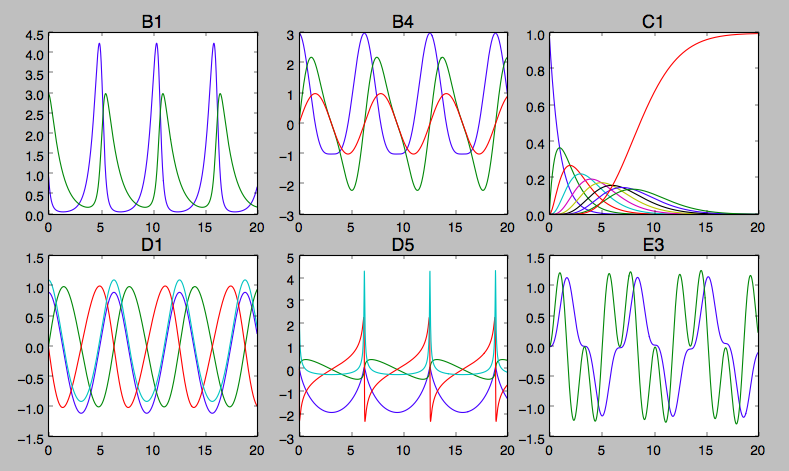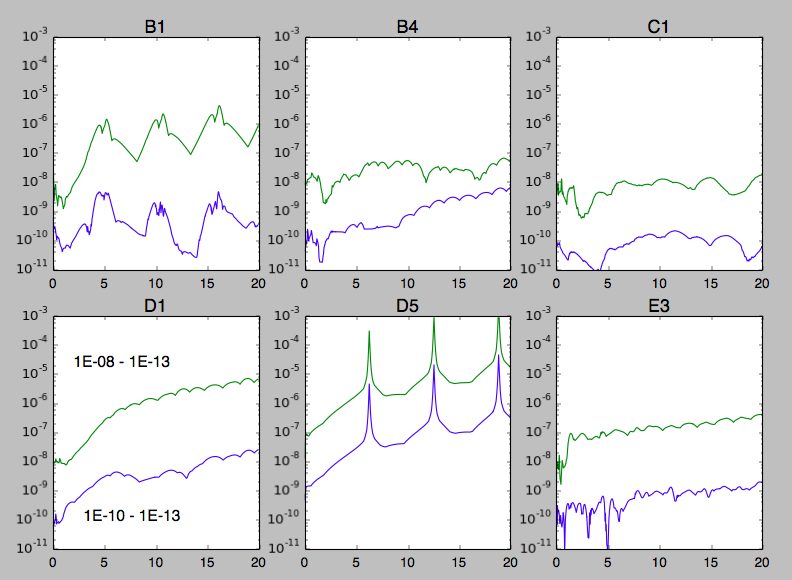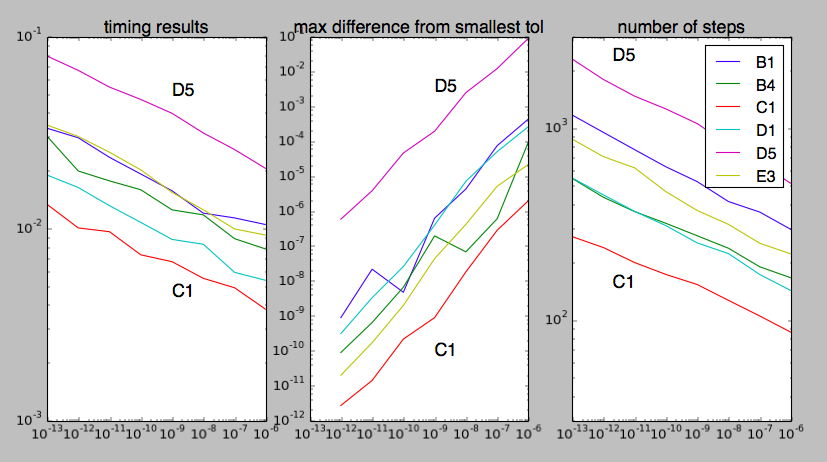需要更好地理解rtol,atol如何在scipy.integrate.odeint中工作
需要更好地理解rtol,atol如何在scipy.integrate.odeint中工作
提问于 2015-11-17 03:23:05
在这里,scipy.integrate.odeint是用rtol = atol从1E-06到1E-13的六个不同的标准ode问题来调用的。我研究了所有较大公差与最小公差的结果之间的最大差异,以得到某种“错误”的表示。对于给定的公差,我很好奇为什么一个问题(D5)给出的错误比另一个问题(C1)差一百万倍,尽管步骤的范围相当窄(在10倍以内)。
在脚本中给出了对ode问题的引用。所有问题都已经很好地规范化了,所以我对rtol和atol进行了类似的处理。
重申一下--我的问题是,为什么不同问题之间的误差以几乎1E+06的因子变化,尽管错误是以容忍为尺度的。当然,C1是“最温和的”,而D5在“近日点”有戏剧性的峰值,但我认为这个例程会在内部调整步长,这样错误就会相似。
编辑:--我添加了“错误”的时间演变过程,这可能会给我们一些启示。



# FROM: "Comparing Numerical Methods for Ordinary Differential Equations"
# T.E. Hull, W.H. Enright, B.M. Fellen and A.E. Sedgwidh
# SIAM J. Numer. Anal. vol 9, no 4, December 1972, pp: 603-637
def deriv_B1(y, x):
return [2.*(y[0]-y[0]*y[1]), -(y[1]-y[0]*y[1])] # "growth of two conflicting populations"
def deriv_B4(y, x):
A = 1./np.sqrt(y[0]**2 + y[1]**2)
return [-y[1] - A*y[0]*y[2], y[0] - A*y[1]*y[2], A*y[0]] # "integral surface of a torus"
def deriv_C1(y, x):
return [-y[0]] + [y[i]-y[i+1] for i in range(8)] + [y[8]] # a radioactive decay chain
def deriv_D1toD5(y, x):
A = -(y[0]**2 + y[1]**2)**-1.5
return [y[2], y[3], A*y[0], A*y[1]] # dimensionless orbit equation
deriv_D1, deriv_D5 = deriv_D1toD5, deriv_D1toD5
def deriv_E1(y, x):
return [y[1], -(y[1]/(x+1.0) + (1.0 - 0.25/(x+1.0)**2)*y[0])] # derived from Bessel's equation of order 1/2
def deriv_E3(y, x):
return [y[1], y[0]**3/6.0 - y[0] + 2.0*np.sin(2.78535*x)] # derived from Duffing's equation
import numpy as np
from scipy.integrate import odeint as ODEint
import matplotlib.pyplot as plt
import timeit
y0_B1 = [1.0, 3.0]
y0_B4 = [3.0, 0.0, 0.0]
y0_C1 = [1.0] + [0.0 for i in range(9)]
ep1, ep5 = 0.1, 0.9
y0_D1 = [1.0-ep1, 0.0, 0.0, np.sqrt((1.0+ep1)/(1.0-ep1))]
y0_D5 = [1.0-ep5, 0.0, 0.0, np.sqrt((1.0+ep5)/(1.0-ep5))]
y0_E1 = [0.6713968071418030, 0.09540051444747446] # J(1/2, 1), Jprime(1/2, 1)
y0_E3 = [0.0, 0.0]
x = np.linspace(0, 20, 51)
xa = np.linspace(0, 20, 2001)
derivs = [deriv_B1, deriv_B4, deriv_C1, deriv_D1, deriv_D5, deriv_E3]
names = ["deriv_B1", "deriv_B4", "deriv_C1", "deriv_D1", "deriv_D5", "deriv_E3"]
y0s = [y0_B1, y0_B4, y0_C1, y0_D1, y0_D5, y0_E3]
timeit_dict, answer_dict, info_dict = dict(), dict(), dict()
ntimes = 10
tols = [10.**-i for i in range(6, 14)]
def F(): # low density of time points, no output for speed test
ODEint(deriv, y0, x, rtol=tol, atol=tol)
def Fa(): # hight density of time points, full output for plotting
return ODEint(deriv, y0, xa, rtol=tol, atol=tol, full_output=True)
for deriv, y0, name in zip(derivs, y0s, names):
timez = [timeit.timeit(F, number=ntimes)/float(ntimes) for tol in tols]
timeit_dict[name] = timez
alist, dlist = zip(*[Fa() for tol in tols])
answer_dict[name] = np.array([a.T for a in alist])
info_dict[name] = dlist
plt.figure(figsize=[10,6])
for i, name in enumerate(names):
plt.subplot(2, 3, i+1)
for thing in answer_dict[name][-1]:
plt.plot(xa, thing)
plt.title(name[-2:], fontsize=16)
plt.show()
plt.figure(figsize=[10, 8])
for i, name in enumerate(names):
plt.subplot(2,3,i+1)
a = answer_dict[name]
a13, a10, a8 = a[-1], a[-4], a[-6]
d10 = np.abs(a10-a13).max(axis=0)
d8 = np.abs(a8 -a13).max(axis=0)
plt.plot(xa, d10, label="tol(1E-10)-tol(1E-13)")
plt.plot(xa, d8, label="tol(1E-08)-tol(1E-13)")
plt.yscale('log')
plt.ylim(1E-11, 1E-03)
plt.title(name[-2:], fontsize=16)
if i==3:
plt.text(3, 1E-10, "1E-10 - 1E-13", fontsize=14)
plt.text(2, 2E-05, "1E-08 - 1E-13", fontsize=14)
plt.show()
fs = 16
plt.figure(figsize=[12,6])
plt.subplot(1,3,1)
for name in names:
plt.plot(tols, timeit_dict[name])
plt.title("timing results", fontsize=16)
plt.xscale('log')
plt.yscale('log')
plt.text(1E-09, 5E-02, "D5", fontsize=fs)
plt.text(1E-09, 4.5E-03, "C1", fontsize=fs)
plt.subplot(1,3,2)
for name in names:
a = answer_dict[name]
e = a[:-1] - a[-1]
em = [np.abs(thing).max() for thing in e]
plt.plot(tols[:-1], em)
plt.title("max difference from smallest tol", fontsize=16)
plt.xscale('log')
plt.yscale('log')
plt.xlim(min(tols), max(tols))
plt.text(1E-09, 3E-03, "D5", fontsize=fs)
plt.text(1E-09, 8E-11, "C1", fontsize=fs)
plt.subplot(1,3,3)
for name in names:
nsteps = [d['nst'][-1] for d in info_dict[name]]
plt.plot(tols, nsteps, label=name[-2:])
plt.title("number of steps", fontsize=16)
plt.xscale('log')
plt.yscale('log')
plt.ylim(3E+01, 3E+03)
plt.legend(loc="upper right", shadow=False, fontsize="large")
plt.text(2E-12, 2.3E+03, "D5", fontsize=fs)
plt.text(2E-12, 1.5E+02, "C1", fontsize=fs)
plt.show()回答 1
Stack Overflow用户
回答已采纳
发布于 2016-05-22 00:48:44
自从我发了这个问题以来,我学到了更多。我们不能只把每一步的数值精度乘以步骤的数目,而是希望得到整体的精度。
如果解有分歧(附近的起始点导致路径随着时间的推移变得更远),那么数值误差就会被放大。每个问题都是不同的--一切都是它应该有的。
Hull等人是学习有关ODE求解器的一个很好的起点。(问题中所示问题的来源)
“比较常微分方程的数值方法”T.E. Hull,W.H. Enright,B.M. Fellen和A.E. Sedgwidh SIAM J. Numer.肛门。第9卷,第4号,1972年12月,第603-637页
页面原文内容由Stack Overflow提供。腾讯云小微IT领域专用引擎提供翻译支持
原文链接:
https://stackoverflow.com/questions/33748601
复制相关文章
相似问题

